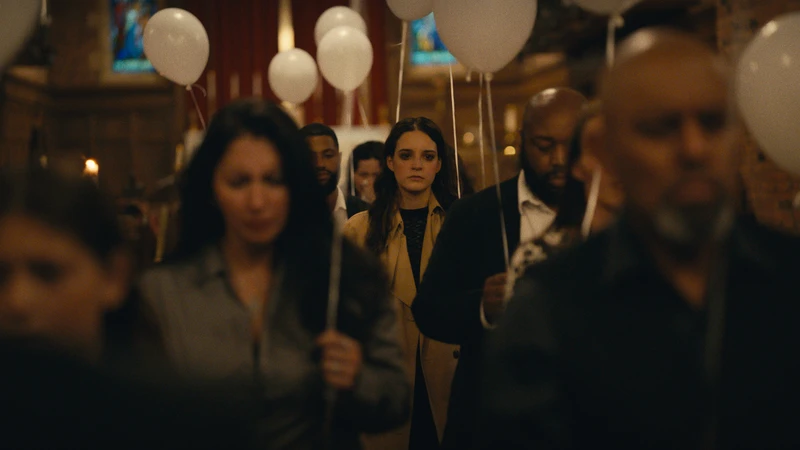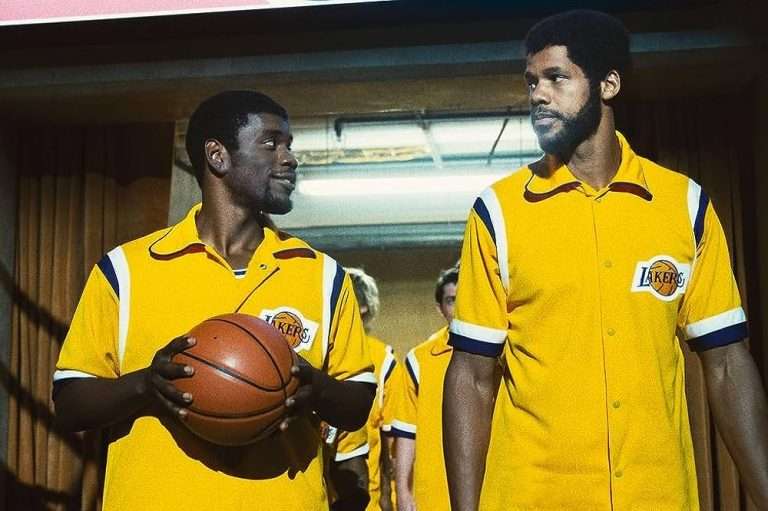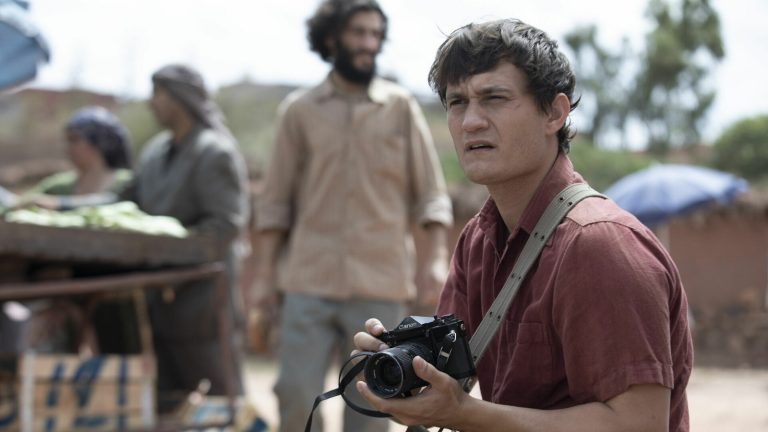Maribel’s pilgrimage through sorrow in “The Mourning Of” does not arrive with the cathartic trumpet of resolution but lingers, haunted, in the dusk‑light between condolence and compulsion. Once she begins attending strangers’ funerals — clandestine in her grief, lying, slipping into pews that are not hers — she becomes both mourner and phantom, a carrier of others’ loss even as hers remains unclaimed.
Natalia Villegas inhabits this ambivalence with a solemn restraint: there is no flourish, no tears that like to fall for effect, only the gait of her footsteps, the same coat she wore for her mother, the vacant ache in her eyes when she offers condolences, not knowing whether she is comforting or stealing solace. Father Tomas (Julio César Cedillo) stands as voice and conscience; not savior, but witness and mild challenger, asking whether her habit is sanctified solace or avoidance of the rupture grief demands.
The film frames these moments not as moral lessons but as fissures between what the world expects – moving on, letting go, and what the heart can bear: that grief may lie not in what is declared, but what is withheld. When Maribel watches others mourn, there is compassion, yes, but also a visceral envy: she is still bound to her own silence. And so the film asks of us: what becomes of the mourner who steps outside customary possession of grief, who borrows others’ rituals and yet cannot lay down her own burden?
In her offerings — soft words of comfort, stolen moments of quiet reverence at the edge of a casket — she is at once seeking and fleeing her own pain. In her posture, in her pauses, she becomes a mirror for every audience member’s unspoken what-ifs. What if I had said one more thing? What if I had let my grief shape me rather than shame me? The power here lies in that ambiguity: Comfort is not always rescue, intrusion can be tender, solace may arrive through witnessing rather than speaking, maybe even through standing at the threshold of two graves, one public, one private.
The film resists neat closure: Maribel doesn’t erase her grief or shatter her pattern of attendance. She’s not made over by forgetting but by remembering that some griefs must be carried into the future, told and retold, witnessed. Maybe the second grief is learning how grief is less about finality as about being-there, less about spilled tears as about un-dying echoes where we don’t expect them.
Maribel’s grief in “The Mourning Of” is not some well-bound wound but something she carries through funeral pamphlets and church aisles, in the breaths she tries to control and the empty space where the voice of her mother had been. She wears the same coat to her mother’s funeral, the earrings the same; those small repetitions become ritual; they tie her to the end of something as she navigates through others’ grief. She attends strangers’ funerals, sharing her body, her compassion, reading the death notices as personal testimonials, highlighting the names and the dates in her paper as if staking territories of loss itself.
“The Mourning of” is a radical act of empathy. It insists that grief, especially over those we’ve lost, is not a journey but a terrain we inhabit indefinitely. Maribel’s wandering among funeral crowds is heartbreaking because it is both a denial and a search — a denial of her solitary mourning, a search for the communion she no longer feels. It echoes, shifts, mutates. And sometimes the way back from loss is not about forgetting, but about learning to breathe beside it. Prayers, and in each frame, the architecture of mourning enfolds her, presses in, yet gives her a place to stand.
Her face is a landscape of longing; Natalia Villegas conveys sorrow without excess, her expressions muted, her eyes reserved, as though she is both participant and observer, both comforter and haunted. Father Tomas (Julio César Cedillo) becomes a mirror and a moral tension: he sees her, questions her, wonders aloud whether her ritual of intrusion is comforting or self‑punishing, whether her steadiness among grief is devotion or denial.

The editing (Jonathan Cuartas) stretches moments of silent observance – the clasp of hands, a hymn drifting in, a flickering church candle – and compresses time so that waiting is felt as weight, that every breath between speeches matters. The sound, too, René G. Boscio’s score, organ resonance, mournful harmonies, mingle with the ambient, the creaking pew, the soft rustle of obituary pages, until grief becomes texture, surround‑sound.
Maribel seems stuck in time, circling her own sorrow via the rituals of strangers; yet, in those rituals, there is also something tender: a soft communion, a sharing of grief that is not hers but becomes shade and counterpoint to what she cannot let go of.
The film does not grant her release. It does not suggest that attending these funerals brings cure. What it offers, instead, is a radical grace — the permission for grief to exist in its quieter edges: not the scream, but the tremor; not the declaration, but the hush; not the letting go, but the holding on. In watching Maribel, we watch ourselves in the corridors of memory, in the obituaries we never forget, in the moments we avoid because we fear the echo.
Maribel’s practice of drifting into strangers’ funerals in “The Mourning Of” becomes more than grief: it is pilgrimage, transgression, assertion. She rides in her car, service notes from her mother’s funeral still pinned inside the sun visor, others strewn across the back seat, each one a cipher she studies for communion. At the Church of the Ascension, she is not a guest; she is a presence.
The rituals are public, yet grief remains gated: who may weep, who may enter, who may vanish after the service ends. Maribel’s attendance — her quiet entering of wakes, yards, and homes to which she has no rightful claim — is an act of insistence, a demand for the access her own sorrow was once denied. She wears again the same coat, the same earrings she wore at her mother’s funeral — a ritual of repetition, an outward costume that becomes mourning’s uniform, marking her continuity with absence.
Because Elizondo does not assign moral judgment, she refuses to define Maribel’s act as pathology or heroism. Is this obsession or devotion? Is this comfort or compulsion? The film will not tell you. Ambiguity is essential. Grief is messy. Her ritual of attendance is both escape and confrontation — an escape from solitude, a confrontation with a death that refuses to release its hold on her.
The spatial logic (car, streets, church, home) charts edges of belonging and exclusion, showing that public mourning rituals are carved by custom: some are given the right to cry, others must weep in secret. Maribel demands no permission. The question the film hammers at quietly is: who gets to claim grief? Who is told, “move on”? Maribel’s insistent attendance isn’t so much sympathy for others as the need for her grief to count in the architecture of ritual, which so routinely erases it.
She yearns for containment, some corner for her grief to breathe, yet it slips beyond her in the decorously constructed space of the funeral. Her intrusiveness interrupts the ritual, interrupts the congregation, interrupts tradition. “The Mourning Of” perpetuates this tension: it doesn’t comfort us by explanation, doesn’t forgive Maribel’s offense. Instead, it leaves open the cleft between communal ritual and personal rupture. It reminds us that grief isn’t an interloper who can go; it’s a voice needing its own space for which the world has no chair. It insists that grief — especially for those we’ve lost — is not a journey to be completed, but a landscape we inhabit forever.
Maribel’s roaming among funeral crowds is tragic because it is both denial and desire — denial of her solitary mourning, and a seeking for the communion she no longer believes herself entitled to. It won’t allow neat closure. In its final frames, we don’t see her made whole. We see the evidence of her yearning, body still beset, memory still at work. That refusal takes courage: too many films crave the tidy ending for grief; this stays inside us. It insists on being felt, on being questioned, challenged. It reminds us that losing never gets forgotten; it resonates, changes, and evolves. Sometimes the way back after losing isn’t forgetting but learning how to breathe next to.






![A Song for You [2021]: ‘NYAFF’ Review – An Important Song Sung From the Margins](https://79468c92.delivery.rocketcdn.me/wp-content/uploads/2021/08/A-Song-for-You.jpeg)

